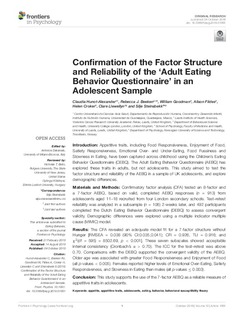| dc.contributor.author | Hunot-Alexander, Claudia | |
| dc.contributor.author | Beeken, Rebecca J | |
| dc.contributor.author | Goodman, William | |
| dc.contributor.author | Fildes, Alison | |
| dc.contributor.author | Croker, Helen | |
| dc.contributor.author | Llewellyn, Clare | |
| dc.contributor.author | Steinsbekk, Silje | |
| dc.date.accessioned | 2020-01-16T07:23:13Z | |
| dc.date.available | 2020-01-16T07:23:13Z | |
| dc.date.created | 2019-11-28T15:55:09Z | |
| dc.date.issued | 2019 | |
| dc.identifier.citation | Frontiers in Psychology. 2019, 10 1-11. | nb_NO |
| dc.identifier.issn | 1664-1078 | |
| dc.identifier.uri | http://hdl.handle.net/11250/2636530 | |
| dc.description.abstract | Introduction: Appetitive traits, including Food Responsiveness, Enjoyment of Food, Satiety Responsiveness, Emotional Over- and Under-Eating, Food Fussiness and Slowness in Eating, have been captured across childhood using the Children’s Eating Behavior Questionnaire (CEBQ). The Adult Eating Behavior Questionnaire (AEBQ) has explored these traits in adults, but not adolescents. This study aimed to test the factor structure and reliability of the AEBQ in a sample of UK adolescents, and explore demographic differences.
Materials and Methods: Confirmatory factor analysis (CFA) tested an 8-factor and a 7-factor AEBQ, based on valid, completed AEBQ responses (n = 913) from adolescents aged 11–18 recruited from four London secondary schools. Test–retest reliability was analyzed in a subsample (n = 106) 2-weeks later, and 492 participants completed the Dutch Eating Behavior Questionnaire (DEBQ) to assess convergent validity. Demographic differences were explored using a multiple indicator multiple cause (MIMIC) model.
Results: The CFA revealed an adequate model fit for a 7-factor structure without Hunger [RMSEA = 0.038 (90% CI:0.035,0.041); CFI = 0.926, TLI = 0.916; and χ2(df = 595) = 8502.69, p < 0.001]. These seven subscales showed acceptable internal consistency (Cronbach’s α > 0.70). The ICC for the test–retest was above 0.70. Comparisons with the DEBQ supported the convergent validity of the AEBQ. Older age was associated with greater Food Responsiveness and Enjoyment of Food (all p-values < 0.005). Females reported higher levels of Emotional Over-Eating, Satiety Responsiveness, and Slowness in Eating than males (all p-values ≤ 0.003).
Conclusion: This study supports the use of the 7-factor AEBQ as a reliable measure of appetitive traits in adolescents. | nb_NO |
| dc.language.iso | eng | nb_NO |
| dc.publisher | Frontiers Media | nb_NO |
| dc.rights | Navngivelse 4.0 Internasjonal | * |
| dc.rights.uri | http://creativecommons.org/licenses/by/4.0/deed.no | * |
| dc.title | Confirmation of the Factor Structure and Reliability of the ‘Adult Eating Behavior Questionnaire’ in an Adolescent Sample | nb_NO |
| dc.type | Journal article | nb_NO |
| dc.type | Peer reviewed | nb_NO |
| dc.description.version | publishedVersion | nb_NO |
| dc.source.pagenumber | 1-11 | nb_NO |
| dc.source.volume | 10 | nb_NO |
| dc.source.journal | Frontiers in Psychology | nb_NO |
| dc.identifier.doi | 10.3389/fpsyg.2019.01991 | |
| dc.identifier.cristin | 1753998 | |
| dc.description.localcode | Copyright © 2019 Hunot-Alexander, Beeken, Goodman, Fildes, Croker, Llewellyn and Steinsbekk. This is an open-access article distributed under the terms of the Creative Commons Attribution License (CC BY). The use, distribution or reproduction in other forums is permitted, provided the original author(s) and the copyright owner(s) are credited and that the original publication in this journal is cited, in accordance with accepted academic practice. No use, distribution or reproduction is permitted which does not comply with these terms. | nb_NO |
| cristin.unitcode | 194,67,40,0 | |
| cristin.unitname | Institutt for psykologi | |
| cristin.ispublished | true | |
| cristin.fulltext | original | |
| cristin.qualitycode | 2 | |

